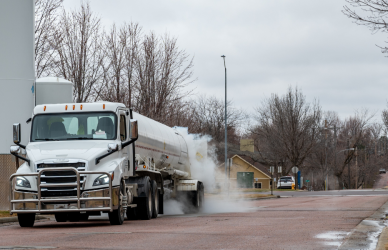Analysts predict that the freight industry may not see a turnaround until 2025 due to factors such as higher interest rates and sluggish spending. The Journal of Commerce Inland Distribution Conference revealed that carriers, who were previously hopeful about a potential recovery, should now expect weak conditions to persist until late 2025.
This prediction is supported by weak U.S. economic data, which was shared during the conference. Challenges such as overflowing retail inventories, increasing interest rates, and high costs are preventing the freight market from bouncing back, despite some positive signs of short-term consumer spending.
“We’re on a downward path,” said Paul Bingham, director of economics and country risk transportation consulting for S&P Global. “Really, if we’re going to get into any recovery in terms of the overall economy, it’s not going to be until 2026.”
Despite analysts’ concerns, the U.S. economy is expected to avoid a recession this year. While growth will be modest, with a projected GDP increase of 2.3% in 2021, it may not surpass 1.5% by 2024, according to S&P Global forecasts.
Positive Signs Emerge Despite Freight Recession, but Rising Costs Pose New Challenges
While carriers continue to face a freight recession, there are some encouraging developments on the horizon.
The Federal Reserve’s efforts to control inflation have impacted consumer spending to some extent, according to Bingham but this hasn’t been enough to push the country into a full economic recession. Consumers are still purchasing goods, but not at a rate that reduces inventory levels.
This spending pattern has led to a normalization of retail inventories. Additionally, the rate at which trucking companies are leaving the market has slowed down, as rates and capacity stabilize.
Unfortunately, higher costs for essential consumer products like fuel and food, along with increasing interest rates on credit cards, car loans, and mortgages, will hinder future spending, warns Bingham.
If consumers aren’t buying, manufacturers won’t produce, which means there won’t be a demand for shipping, explains Bingham. He emphasizes that there won’t be a rebound in online purchases or increased demand for goods that would drive freight demand.
2023 Peak Season Expected to be Typical, Trucking Industry Experts Say
According to industry experts, the upcoming peak season in 2023 is projected to be in line with historical trends. Larry Gross, president and founder of Gross Transportation and Consulting, predicts that the peak in intermodal services will begin during the last week of September, which is consistent with past data. In fact, recent statistics show that intermodal volume is currently 6.4% above the average non-holiday week, indicating a normal peak season.
This forecast aligns with the outlook shared by other trucking executives. During the Deutsche Bank’s 2023 Transportation Conference, J.B. Hunt Transport Services Intermodal President and EVP Darren Field expressed that customers are not anticipating a significant peak season. Similarly, Werner Enterprises Chairman, President, and CEO Derek Leathers believes that the peak season will be muted due to uncertainty surrounding the holiday outlook.
Looking toward the future, Bobby Holland, vice president and director of freight business analytics at U.S. Bank, emphasizes the importance of new home construction as a potential indicator of economic improvement. Strong sales in the housing market can stimulate other sectors by increasing shipments of building materials and boosting sales of various home goods and appliances.
Overall, while the economic rebound is dependent on various factors, experts suggest that monitoring new home sales could provide valuable insight into the direction of the economy.
“We know that interest rates are still higher and that housing starts are at their lows,” Holland said. “When you couple that with minimal housing inventories in some areas of the country, we’re watching to see whether this continues to suppress freight.”
Source: Trucking Dive











